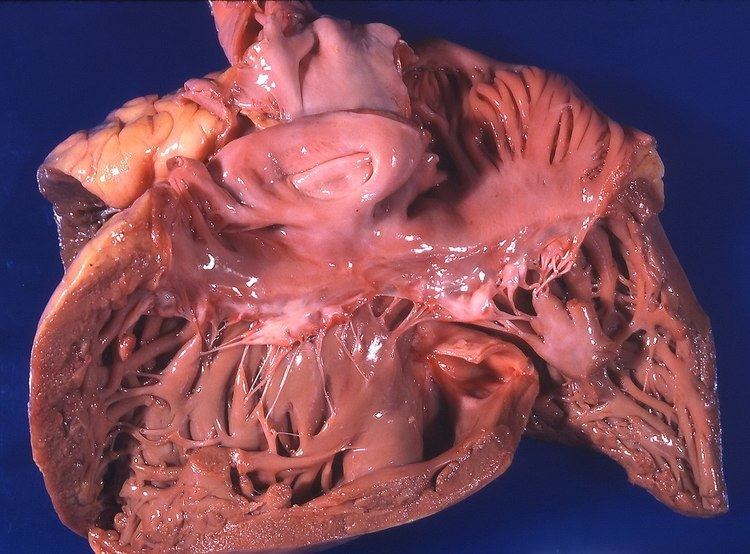ICD-9-CM 415.0 MeSH D011660 | ICD-10 I26, I27 MedlinePlus 000129 | |
 | ||
Pulmonary heart disease, also known as cor pulmonale is the enlargement and failure of the right ventricle of the heart as a response to increased vascular resistance (such as from pulmonic stenosis) or high blood pressure in the lungs.
Contents
Chronic pulmonary heart disease usually results in right ventricular hypertrophy (RVH), whereas acute pulmonary heart disease usually results in dilatation. Hypertrophy is an adaptive response to a long-term increase in pressure. Individual muscle cells grow larger (in thickness) and change to drive the increased contractile force required to move the blood against greater resistance. Dilatation is a stretching (in length) of the ventricle in response to acute increased pressure.
To be classified as pulmonary heart disease, the cause must originate in the pulmonary circulation system. Two causes are vascular changes as a result of tissue damage (e.g. disease, hypoxic injury), and chronic hypoxic pulmonary vasoconstriction. If left untreated, then death may result, RVH due to a systemic defect is not classified as pulmonary heart disease. The heart and lungs are intricately related; whenever the heart is affected by a disease, the lungs will follow and vice versa. Pulmonary heart disease is by definition a condition when the lungs cause the heart to fail.
Signs and symptoms
The symptoms/signs of pulmonary heart disease (cor pulmonale) can be non-specific and depend on the stage of the disorder, and can include blood backing up into the systemic venous system, including the hepatic vein. As pulmonary heart disease progresses, most individuals will develop symptoms like:
Causes
The causes of pulmonary heart disease (cor pulmonale) are the following:
Pathophysiology
The pathophysiology of pulmonary heart disease (cor pulmonale) has always indicated that an increase in right ventricular afterload causes RV failure (pulmonary vasoconstriction, anatomic disruption/pulmonary vascular bed and increased blood viscosity are usually involved ), however most of the time, the right ventricle adjusts to an overload in chronic pressure. According to Voelkel, et al., pressure overload is the initial step for changes in RV, other factors include:
Diagnosis
The diagnosis of pulmonary heart disease is not easy as both lung and heart disease can produce similar symptoms. Therefore, the differential diagnosis should assess:
Among the investigations available to determine cor pulmonale are:
An ECG will often show a characteristic peaked P wave, termed P pulmonale.
Prevention
In terms of the prevention of cor pulmonale, while not all lung diseases can be prevented one can reduce the risk of lung disease, this means avoiding or discontinuing smoking. Patients with emphysema or chronic obstructive lung disease can end up with right heart failure.
Treatment
The treatment for cor pulmonale can include the following: antibiotics, expectorants, oxygen therapy, diuretics, digitalis, vasodilators, and anticoagulants. Some studies have indicated that Shenmai injection with conventional treatment is safe and effective for cor pulmonale (chronic).
Treatment requires diuretics (to decrease strain on the heart). Oxygen is often required to resolve the shortness of breath. Additionally, oxygen to the lungs also helps relax the blood vessels and eases right heart failure. When wheezing is present,the majority of individuals require a bronchodilator. A variety of drugs have been developed to relax the blood vessels in the lung, calcium channel blockers are used but only work in few cases and according to NICE are not recommended for use at all.
Anticoagulants are used when venous thromboembolism is present. Venesection is used in severe secondary polycythaemia (because of hypoxia), which improves symptoms though survival rate has not been proven to increase.Finally, transplantation of single/double lung in extreme cases of cor pulmonale is also an option.
Epidemiology
The epidemiology of pulmonary heart disease (cor pulmonale) accounts for 7% of all heart disease in the U.S. According to Weitzenblum, et al., the mortality that is related to cor pulmonale is not easy to ascertain, as it is a complication of COPD.
